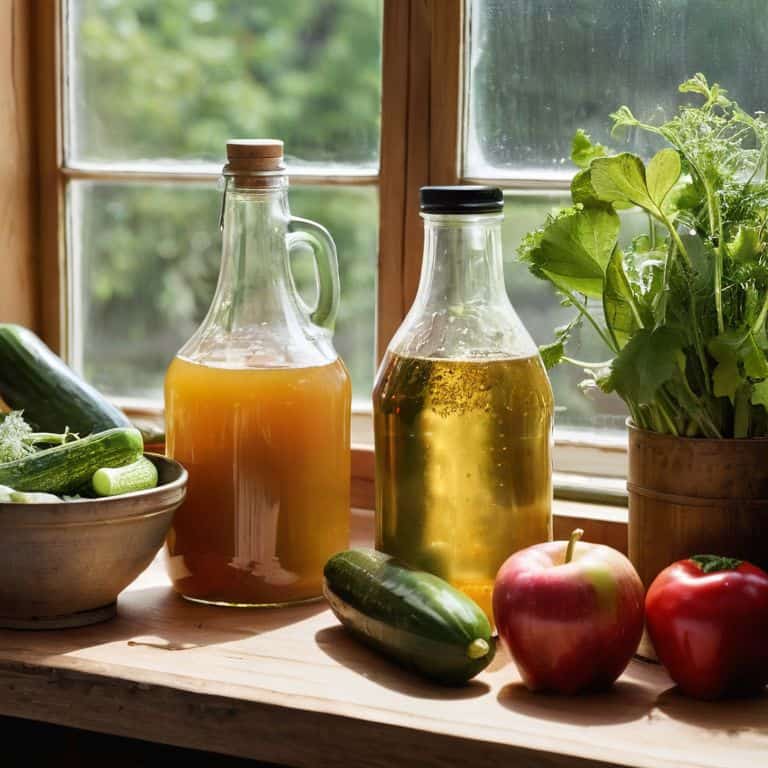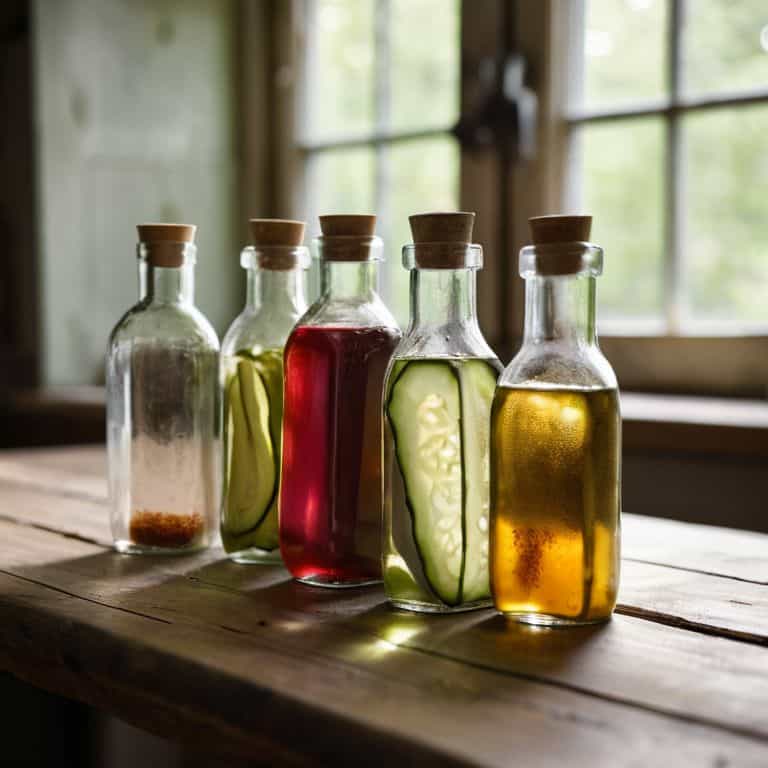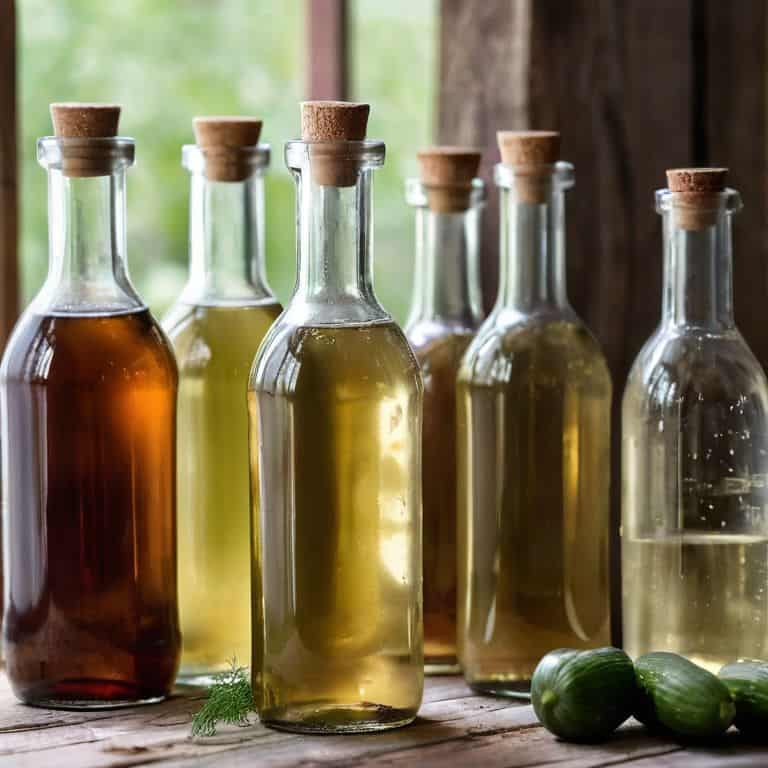I still remember the first time I got hooked on pickling – it was like a whole new world of flavors opened up for me. But as I dove deeper into the world of what is the best vinegar for pickling, I realized that everyone seemed to have an opinion, and most of them were overly complicated. I mean, who needs a $20 bottle of artisanal vinegar to make great pickles? Not me, that’s for sure. I’ve spent years experimenting with different types of vinegar, and I’ve come to one conclusion: it’s not about the price tag, it’s about the taste.
So, if you’re like me and you’re tired of all the hype surrounding pickling vinegar, you’re in the right place. In this article, I’ll share my no-nonsense approach to finding the best vinegar for pickling, based on my own experience and experiments. I’ll give you the lowdown on what works, what doesn’t, and how to make delicious pickles with ingredients you can actually find in your local store. My goal is to empower you to take control of your pickling game, and to show you that with a little creativity and patience, you can create amazing flavors that will impress even the most discerning palates.
Table of Contents
Whats Best for Pickling

When it comes to pickling, the type of vinegar you use can make all the difference. I’ve experimented with various pickling vinegar ratios to find the perfect balance for my homemade jars. For me, it’s all about achieving that perfect tanginess without overpowering the natural flavors of the ingredients. I’ve found that using a mixture of apple cider vinegar and white wine vinegar creates a unique _flavor profile_ that complements a wide range of vegetables.
Natural pickling methods are all about embracing the process and letting nature take its course. I love using vinegar acidity levels to my advantage, creating an environment where the good bacteria can thrive and add depth to my pickles. It’s amazing how a simple _pickling liquid recipe_ can elevate the flavors of even the humblest ingredients. I’ve spent hours perfecting my own recipes, and I’m always excited to share them with fellow pickling enthusiasts.
In my experience, the key to successful pickling lies in finding the right balance between acidity and flavor. I’ve experimented with various vinegar substitutes, from lemon juice to verjuice, to create unique and exciting flavor combinations. Whether you’re a seasoned pro or just starting out, I encourage you to get creative with your pickling liquid recipes and find the perfect blend to suit your taste. Remember, it’s all about experimentation and having fun with the process!
Natural Pickling With Flair
When it comes to natural pickling, I’m all about adding a bit of flair to the process. For me, that means experimenting with different ingredients and techniques to create unique flavor profiles. I love using fresh herbs and spices to give my pickles a distinct taste.
I’ve found that using seasonal ingredients is key to creating pickles that are not only delicious but also reflective of the time of year. Whether it’s using fresh dill in the summer or warm spices in the winter, the result is a pickle that’s full of character and flavor.
Vinegar Acidity for Perfect Brine
When it comes to creating the perfect brine, acidity levels play a crucial role. I’ve found that using a vinegar with the right balance of acidity helps to bring out the unique flavors of the ingredients. For me, it’s all about experimenting with different types of vinegar to find the one that works best for each recipe.
To achieve that perfect balance, I look for vinegar with a consistent acidity level, usually around 5%. This allows me to control the fermentation process and ensures that my pickles turn out tangy, but not too sour.
Get Your Brine on Right

To really get your brine on, you need to understand the importance of balance in your pickling liquid recipe. I’ve found that a good pickling vinegar ratio is key to achieving that perfect tanginess. It’s all about experimenting with different flavor profiles in pickling to find what works best for you. For me, it’s about combining the right amount of vinegar with natural ingredients like garlic, dill, or spices to create a truly unique taste experience.
When it comes to natural pickling methods, I’m a big fan of using ingredients that are in season and readily available. This not only ensures that my pickles are bursting with flavor, but also helps to reduce waste and support local farmers. By using a variety of pickling vinegar substitutes, such as lemon juice or wine, you can add an extra layer of complexity to your pickles. Just be sure to adjust your vinegar acidity levels accordingly to avoid an overpowering flavor.
As you experiment with different pickling liquid recipes, remember that it’s all about finding the right balance of sweet, sour, and salty flavors. Don’t be afraid to think outside the box and try new combinations – after all, that’s what makes pickling so much fun! By embracing the process and being willing to take a few risks, you’ll be well on your way to creating your own signature pickles that are sure to impress.
Flavor Profiles in Homemade Pickles
When it comes to creating unique flavor profiles in homemade pickles, I always say experimentation is key. I love trying out different combinations of spices and seasonings to give my pickles a one-of-a-kind taste. From classic dill to more adventurous flavors like garlic and chili flakes, the possibilities are endless.
To take your pickles to the next level, consider layering flavors by adding different ingredients at various stages of the pickling process. This can include adding fresh herbs during the last minute of brining or mixing in some spicy mustard seeds for an extra kick. The result is a complex, nuanced flavor that will make your homemade pickles truly stand out.
Pickling Liquid Recipes Unleashed
As I experiment with different vinegars, I love unleashing my creativity with unique flavor combinations. I’ve found that mixing and matching various acids and spices can lead to some truly amazing pickling liquid recipes. From classic dill to spicy kimchi-inspired blends, the possibilities are endless.
I’ve had great success with a simple recipe that uses fresh dill weed to add a bright, freshness to my pickles. By combining it with the right amount of vinegar and spices, I can create a deliciously tangy brine that elevates my pickles to the next level.
My Top 5 Picks for Perfect Pickling Vinegar

- Choose a vinegar that’s got some character – I’m talking about apple cider vinegar or white wine vinegar for a more complex flavor profile
- Don’t be afraid to experiment with different acidity levels – a good rule of thumb is to start with a 5% acidity and adjust to taste
- Consider the type of pickles you’re making – for example, a lighter vinegar like rice vinegar is perfect for delicate veggies like cucumbers or carrots
- Remember, the quality of your vinegar matters – opt for a high-quality, artisanal vinegar whenever possible for the best flavor
- Lastly, don’t forget to taste as you go – the best pickling vinegar is one that’s balanced and tangy, so don’t be shy about adjusting your recipe on the fly
Three Key Takeaways for the Perfect Pickle
I’ve found that the best vinegar for pickling is one that balances flavor and acidity – for me, that’s often a mix of apple cider and white wine vinegar
Experimenting with different vinegar acidity levels can make all the difference in achieving that perfect brine – don’t be afraid to get a little scientific and test out various ratios
Remember, the fun of pickling is in the experimentation, so don’t be limited by traditional recipes – try infusing your pickling liquid with unique flavors like garlic, dill, or even chili peppers to create one-of-a-kind pickles
The Pickling Truth
I’ve found that the best vinegar for pickling isn’t just about the type, but about the story it tells – of tradition, of experimentation, and of the beautiful balance between tangy and sweet that makes your taste buds do the happy dance!
Tom Navarro
Conclusion: Bringing It All Together
As we wrap up our journey to find the best vinegar for pickling, it’s clear that the key to unlocking amazing flavors lies in experimentation and understanding the nuances of different vinegar types. We’ve explored the importance of natural pickling with flair, delved into the world of vinegar acidity for perfect brine, and even unleashed a plethora of pickling liquid recipes to get you started. Whether you’re a seasoned pro or just beginning to dip your toes into the world of homemade pickles, remembering that flavor profiles in homemade pickles are endlessly customizable is crucial. By embracing this mindset, you’ll be well on your way to creating pickles that are not only tangy and delicious but also uniquely yours.
So, the next time you’re at your local market or rummaging through your garden, don’t be afraid to think outside the jar and imagine the incredible pickles you could be making. With a little patience, practice, and the right vinegar by your side, you’ll be crafting tangy masterpieces that will impress friends and family alike. The world of pickling is vast and wonderfully weird, and I wholeheartedly encourage you to dive in, get a little messy, and make it your own. Happy pickling, and I look forward to seeing the amazing creations you’ll be sharing from your very own fermentation station!
Frequently Asked Questions
Can I use any type of vinegar for pickling or are there specific ones that work best?
Honestly, not all vinegars are created equal for pickling. I swear by apple cider vinegar or white wine vinegar for that perfect balance of tang and flavor. Avoid balsamic, it’s too sweet, and distilled white vinegar can be too harsh. Experiment with different types to find your perfect brine!
How does the acidity level of vinegar affect the flavor and texture of my pickles?
Acidity level is key – it balances flavor and crunch. I find that a higher acidity, around 5%, gives my pickles a nice tang and snappy texture, while lower acidity can make them softer and more prone to spoilage. Experimenting with different levels has helped me nail the perfect balance for my homemade dills.
Are there any creative or unconventional vinegar options I can use to give my pickles a unique flavor profile?
I love experimenting with unique vinegars – try using apple cider vinegar for a sweeter pickle or white wine vinegar for a more delicate flavor. You can even infuse your own vinegar with garlic, dill, or chili peppers for an extra kick. The possibilities are endless, and it’s a great way to add a personal touch to your homemade pickles!
